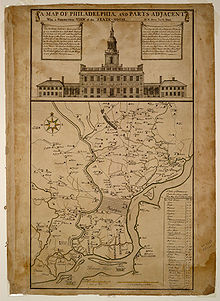Portal:Pennsylvania
The Pennsylvania Portal Pennsylvania (/ˌpɛnsɪlˈveɪniə/ , lit. 'Penn's forest country'), officially the Commonwealth of Pennsylvania (Pennsylvania Dutch: Pennsylvanie), is a state spanning the Mid-Atlantic, Northeastern, Appalachian, and Great Lakes regions of the United States. Pennsylvania borders Delaware to its southeast, Maryland to its south, West Virginia to its southwest, Ohio and the Ohio River to its west, Lake Erie and New York to its north, the Delaware River and New Jersey to its east, and the Canadian province of Ontario to its northwest. Pennsylvania was founded in 1681 through a royal land grant to William Penn, the son of the state's namesake. Prior to that, between 1638 and 1655, a southeast portion of the state was part of New Sweden, a Swedish Empire colony. Established as a haven for religious and political tolerance, the colonial-era Province of Pennsylvania was known for its relatively peaceful relations with native tribes, innovative government system, and religious pluralism. Pennsylvania played a vital and historic role in the American Revolution and the ultimately successful quest for independence from the British Empire, hosting the First and Second Continental Congress, leading to the adoption of the Declaration of Independence and the formation of the Continental Army. On December 12, 1787, Pennsylvania became the second state to ratify the U.S. Constitution. The bloodiest battle of the American Civil War, at Gettysburg over three days in July 1863, proved the war's turning point, leading to the Union's preservation. Throughout the late 19th and 20th centuries, the state's manufacturing-based economy contributed to the development of much of the nation's early infrastructure, including key bridges, skyscrapers, and military hardware used in U.S.-led victories in World War I, World War II, and the Cold War. Pennsylvania's geography is highly diverse. The Appalachian Mountains run through the center of the state; the Allegheny and Pocono mountains span much of Northeastern Pennsylvania; close to 60% of the state is forested. While it has only 140 miles (225 km) of waterfront along Lake Erie and the Delaware River, Pennsylvania has the most navigable rivers of any state in the nation, including the Allegheny, Delaware, Genesee, Ohio, Schuylkill, Susquehanna, and others. (Full article...) This is a Featured article, which represents some of the best content on English Wikipedia..
The Philadelphia Inquirer, often referred to simply as The Inquirer, is a daily newspaper headquartered in Philadelphia, Pennsylvania. Founded on June 1, 1829, The Philadelphia Inquirer is the third-longest continuously operating daily newspaper in the nation. The newspaper has the largest circulation of any newspaper in both Pennsylvania and the Delaware Valley metropolitan region, which includes Philadelphia and its surrounding communities in southeastern Pennsylvania, South Jersey, northern Delaware, and the northern Eastern Shore of Maryland. As of 2020, the newspaper has the 17th-largest circulation of any newspaper in the United States As of 2020, The Inquirer has won 20 Pulitzer Prizes. (Full article...)Selected geography article -Hull Creek (also known as Hulls Creek) is a tributary of the Lackawanna River in Lackawanna County, Pennsylvania, in the United States. It is approximately 4.1 miles (6.6 km) long and flows through Scott Township, Blakely, and Dickson City. The watershed of the creek has an area of 3.22 square miles (8.3 km2). The creek is considered to be impaired by habitat alteration. It is a perennial stream, but experiences some flow loss. A waterfall system known as the Blakely Falls are on the creek, in a post-glacial valley. It also flows through a deep water gap. Channelization work was done on the creek in 1975 by the Pennsylvania Department of Environmental Resources, which has had the effect of reducing flooding. Hull Creek is a second-order stream with some wetlands in its watershed. Its relatively narrow watershed occupies parts of Scott Township, Blakely, Archbald, and Dickson City. Several flooding events have occurred on Hull Creek. The creek is designated as a Coldwater Fishery and a Migratory Fishery. In 2013, it received a habitat assessment score of 159 on a scale of 0 to 200. Macroinvertebrate taxa such as mayflies (Ephemeroptera), stoneflies (Plecoptera), and caddis flies (Trichoptera) inhabit the creek as well. (Full article...)Selected image -Did you know -
Related portalsWikiprojectsThis is a Good article, an article that meets a core set of high editorial standards.
 The city of Philadelphia was founded in 1682 by William Penn in the English Crown Province of Pennsylvania between the Delaware and Schuylkill rivers. Before then, the area was inhabited by the Lenape people. Philadelphia quickly grew into an important colonial city and during the American Revolution was the site of the First and Second Continental Congresses. After the Revolution the city was chosen to be the temporary capital of the United States. At the beginning of the 19th century, the federal and state governments left Philadelphia, but the city remained the cultural and financial center of the country. Philadelphia became one of the first U.S. industrial centers and the city contained a variety of industries, the largest being textiles. After the American Civil War Philadelphia's government was controlled by a Republican political machine and by the beginning of the 20th century Philadelphia was described as "corrupt and contented." Various reform efforts slowly changed city government with the most significant in 1950 where a new city charter strengthened the position of mayor and weakened the Philadelphia City Council. At the same time Philadelphia moved its supports from the Republican Party to the Democratic Party, which has since created a strong Democratic organization. (Full article...)Selected article -During the American Civil War, the Commonwealth of Pennsylvania played a critical role in the Union, providing a substantial supply of military personnel, equipment, and leadership to the Federal government. The state raised over 360,000 soldiers for the Federal armies. It served as a significant source of artillery guns, small arms, ammunition, armor for the new revolutionary style of ironclad types of gunboats for the rapidly expanding United States Navy, and food supplies. The Phoenixville Iron Company by itself produced well over 1,000 cannons, and the Frankford Arsenal was a major supply depot. Pennsylvania was the site of the bloodiest battle of the war, the Battle of Gettysburg, which became widely known as one of the turning points of the Civil War. Numerous more minor engagements and skirmishes were also fought in Pennsylvania during the 1863 Gettysburg Campaign, as well as the following year during a Confederate cavalry raid that culminated in the burning of much of Chambersburg, Pennsylvania. (Full article...)Pennsylvania news
CategoriesState factsState Facts
State symbols
Pennsylvania topicsGeneral imagesThe following are images from various Pennsylvania-related articles on Wikipedia.
Associated WikimediaThe following Wikimedia Foundation sister projects provide more on this subject:
Discover Wikipedia using portals |
































































